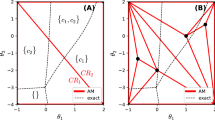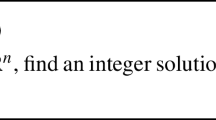Abstract
We study the equivalence among a nonconvex QOP, its CPP and DNN relaxations under the assumption that the aggregate and correlative sparsity of the data matrices of the CPP relaxation is represented by a block-clique graph G. By exploiting the correlative sparsity, we decompose the CPP relaxation problem into a clique-tree structured family of smaller subproblems. Each subproblem is associated with a node of a clique tree of G. The optimal value can be obtained by applying an algorithm that we propose for solving the subproblems recursively from leaf nodes to the root node of the clique-tree. We establish the equivalence between the QOP and its DNN relaxation from the equivalence between the reduced family of subproblems and their DNN relaxations by applying the known results on: (1) CPP and DNN reformulation of a class of QOPs with linear equality, complementarity and binary constraints in 3 nonnegative variables. (2) DNN reformulation of a class of quadratically constrained convex QOPs with any size. (3) DNN reformulation of LPs with any size. As a result, we show that a QOP whose subproblems are the QOPs mentioned in (1), (2) and (3) is equivalent to its DNN relaxation, if the subproblems form a clique-tree structured family induced from a block-clique graph.



Similar content being viewed by others
References
Agler, J., Helton, J .W., McCullough, S., Rodman, L.: Positive semidefinite matrices with a given sparsity pattern. Linear Algebr. Appl. 107, 101–149 (1988)
Arima, N., Kim, S., Kojima, M.: A quadratically constrained quadratic optimization model for completely positive cone programming. SIAM J. Optim. 23, 2320–2340 (2013)
Arima, N., Kim, S., Kojima, M., Toh, K.C.: Lagrangian-conic relaxations, Part I: a unified framework and its applications to quadratic optimization problems. Pac. J. of Optim. 14(1), 161–192 (2018)
Arima, N., Kim, S., Kojima, M., Toh, K.C.: A robust Lagrangian-DNN method for a class of quadratic optimization problems. Comput. Optim. Appl. 66, 453–479 (2017)
Berman, A., Shaked-Monderer, N.: Compoletely Positive Matrices. World Scientific, Singapore (2003)
Blair, J.R.S., Peyton, B.: An introduction to chordal graphs and clique trees. In: Liu, J.W.H., George, A., Gilbert, J.R. (eds.) Graph Theory and Sparse Matrix Computation. Springer, New York (1993)
Bomze, I.M., Cheng, J., Dickinson, P.J.C., Lisser, A.: A fresh CP look at mixed-binary QPs: new formulations and relaxations. Math. Program. 166, 159–184 (2017)
Burer, S.: On the copositive representation of binary and continuous non-convex quadratic programs. Math. Program. 120, 479–495 (2009)
Drew, J.H., Johnson, C.R.: The completely positive and doubly nonnegative completion problems. Linear Multilinear Algebr. 44, 85–92 (1998)
Fujie, T., Kojima, M.: Semidefinite programming relaxation for nonconvex quadratic programs. J. Global Optim. 10, 367–368 (1997)
Fujisawa, K., Kim, S., Kojima, M., Okamoto, Y., Yamashita, M.: User’s Manual for SparseCoLO: Conversion Methods for SPARSE Conic-form Linear Optimization Problems. Technical Report B-453. Dept. of Mathematical and Computing Sciences, Tokyo Institute of Technology, Tokyo 152-8852 (2009)
Fukuda, M., Kojima, M., Murota, K., Nakata, K.: Exploiting sparsity in semidefinite programming via matrix completion. I: general framework. SIAM J. Optim. 11, 647–674 (2000)
Gron, R., Johnson, C.R., Sá, E.M., Wolkowicz, H.: Positive definite completions of partial Hermitian matrices. Linear Algebr. Appl. 58, 109–124 (1984)
Ito, N., Kim, S., Kojima, M., Takeda, A., Toh, K.C.: BBCPOP: A sparse doubly nonnegative relaxation of polynomial optimization problems with binary, box and complementarity constraints. ACM Trans. Math. Softw. 45(3), 34 (2019)
Johnson, C.R., Smith, R.I.: The completion problem for M-matrices and inverse M-matrices. Linear Algebr. Appl. 241–243, 655–667 (1996)
Kim, S., Kojima, M.: Exact solutions of some nonconvex quadratic optimization problems via SDP and SOCP relaxations. Comput. Optim. Appl. 26, 143–154 (2003)
Kim, S., Kojima, M., Toh, K.C.: A Lagrangian-DNN relaxation: a fast method for computing tight lower bounds for a class of quadratic optimization problems. Math. Program. 156, 161–187 (2016)
Kim, S., Kojima, M., Toh, K.C.: A geometrical analysis of a class of nonconvex conic programsfor convex conic reformulations of quadratic and polynomial optimization problems. SIAM J. Optim. (to appear)
Kobayashi, M., Kim, S., Kojima, M.: Correlative sparsity in primal-dual interior-point methods for LP, SDP, and SOCP. Appl. Math. Optim. 58, 69–88 (2008)
Low, S.H.: Convex relaxation of optimal power flow—part I: formulations and equivalence. IEEE Control Netw. Syst. 1, 15–27 (2014)
Toh, K.C., Todd, M.J., Tutuncu, R.H.: SDPT3—a Matlab software package for semidefinite programming. Optim. Methods Softw. 11, 545–581 (1999)
Vandenbergh, L., Andersen, M.S.: Chordal Graphs and Semidefinite Optimization. Foundations and Trend in Optimization, vol. 1. Now Publishers Inc., Hanover (2014)
Waki, H., Kim, S., Kojima, M., Muramatsu, M.: Sums of squares and semidefinite programming relaxations for polynomial optimization problems with structured sparsity. SIAM J. Optim. 17, 218–242 (2006)
Author information
Authors and Affiliations
Corresponding author
Additional information
Publisher's Note
Springer Nature remains neutral with regard to jurisdictional claims in published maps and institutional affiliations.
The research was supported by NRF 2017-R1A2B2005119. This research was supported by Grant-in-Aid for Scientific Research (A) 26242027. This research is supported in part by the Ministry of Education of Singapore under Academic Research Fund Grant Number: R-146-000-257-112.
Rights and permissions
About this article
Cite this article
Kim, S., Kojima, M. & Toh, KC. Doubly nonnegative relaxations are equivalent to completely positive reformulations of quadratic optimization problems with block-clique graph structures. J Glob Optim 77, 513–541 (2020). https://doi.org/10.1007/s10898-020-00879-y
Received:
Accepted:
Published:
Issue Date:
DOI: https://doi.org/10.1007/s10898-020-00879-y
Keywords
- Equivalence of doubly nonnegative relaxations and completely positive programs
- Sparsity of completely positive reformulations
- Aggregate and correlative sparsity
- Block-clique graphs
- Completely positive and doubly nonnegative matrix completion
- Exact optimal values of nonconvex QOPs




